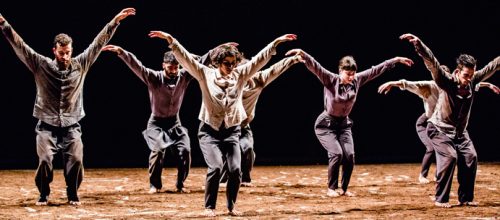


Saturday 8 december 11:00

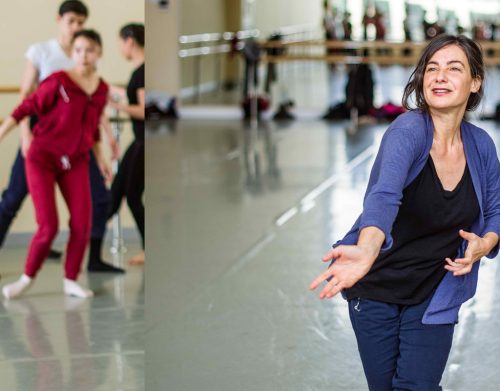
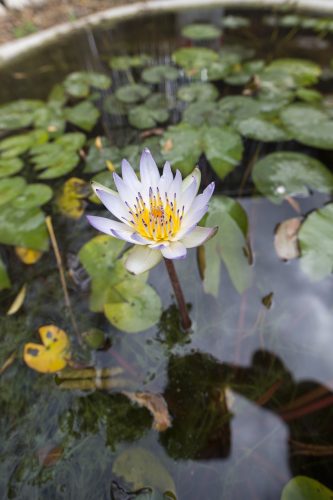
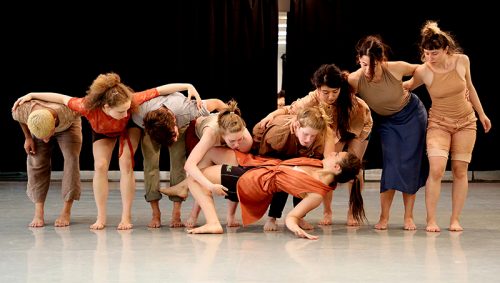
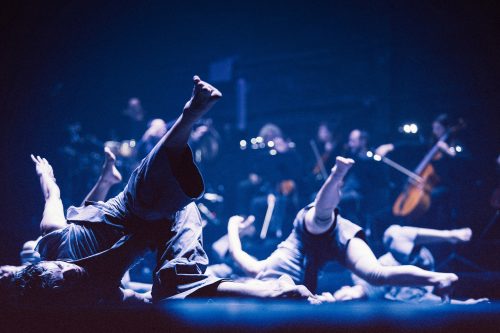
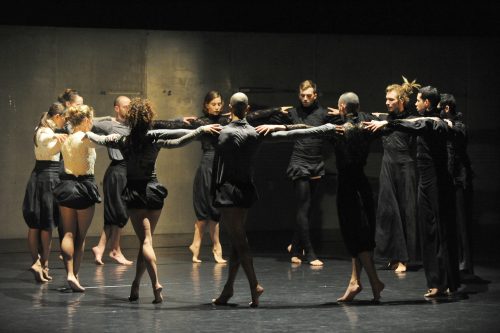
Balet. The Vertigo Dance Company from Jerusalem is showing the rousing piece “Vertigo 20” by choreographer Noa Wertheim. The piece premiered for the occasion of the 20th anniversary of the founding of the group.
During the beginning and the end floating balloons are hinting at a funfair situation, together with music that reminds you of barrel organs, which could be derived from a circus. But that doesn’t mean that we are actually at a funfair or a circus. Rather we are located in a realm of images and phantasy. In the one-hour sequence of scenes “Vertigo 20” everything is only indicated – and like this left to the imagination of the audience.
The performance is a Best-of-compilation of choreographies, elaborated by the Vertigo Dance Company in 20 years of their existence by Noa Wertheim and her partner Adi Sha’al, who founded the company in 1992. As a “Potpourri” it is surprisingly homogeneous and round, just the one or other alternation appears abruptly. On the one hand side Noa Wertheim invented an own dancing language for her company, which is based on the other hand on a philosophy of life in which the ecological awareness has an important role.
Quiet entry
It takes a certain time until which the versatile production takes the ride. Afterwards speedy and rapid scenes are changing with touching intimacy. In the first 20 minutes the young dancers – five women and six men – are moving rather calm and measured, interrupted by violent, cutting arm movements, that sometimes remind of puppets or when the dancers form a formation the military drill. Indeed Sha’al had the idea for the name “Vertigo” – dizziness – during his military training at the Israeli air force.
The soundtrack by Ran Bagno with elements of the waltz, march and techno, oriental elements and Israeli folk music, with accordion and drumbeats often acts archaic and suggests initiation rituals, which picks out the relationship between the single to the whole as a central theme. This impression is underlined by the stage set: it consists of three grey walls with small ledges: On them the dancers are sitting like sculptures, which are waiting to return to life. Also the black-and-white costumes (by Rakefet Levy, from whom is also the stage set) are ambiguous, which combine Victorian clothing and sports trousers; especially noticeable are the towering hairstyles of some of the female dancers – a fabulous idea. The play of the shadows on the walls are able to magnify the space and double the dance scenes (Light. Dani Fishof).
Hardly noticeable transitions
The magic of the performance results not least from the hardly noticeable transitions between the dancing pieces: from one moment to the other the images has changed, instead of a compact group, where the dancers act like mechanical puppets, occurs a circuit that increases into an overexcited runout: an enthralling, orgiastic celebration, a dance of the living. Close to the ending even slapstick elements and a smiling group image like in the silent film era can be found; it only lights up briefly, like an image out of a dream. Enchanting also the last scene, when floating, yellow glowing balloons are selected and single dancers with nearly unseen movements are stepp9ing into the front – this scene can be read as an allegory read on dance, which is nothing else than a dream under the conditio0ns of gravity, earthbound lightness.
Helmut Dworschak, in: Der Landbote, Sat. Oct. 7, 2017, p. 9
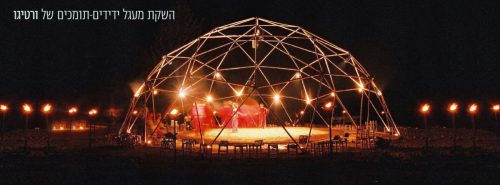
The new work composed by choreographer Noa Wertheim for the Vertigo Dance Company of Jerusalem had its premiere yesterday evening at the Karmiel Dance Festival.
Within the bamboo frame of a geodesic dome constructed in lush greenery, a lyric ceremony took place, wholly based on experiencing nature. Dancers were dancing on a circular surface of earth, and the audience surrounded them on all sides, sitting on wooden stools or on the ground. Weather, changes in lighting from day to night, and external rustling, presented the dancers of the Vertigo Dance Company with not an inconsiderable challenge. The audience, too, might be distracted now and then from the action on stage.
Wertheim’s point of departure in Birth of the Phoenix is the brown, sandy earth. A dancer scuttling on the ground sprouts and separates from it and then scatters in space. Alongside elements derived from the languages of Tai Chi and contact improvisation, Wertheim succeeds, with curved and fluid motion, in combining physicality and spirituality. Excellent Alex Shmurak makes her entrance to the ring with a movement that is expansive and confident. A whistle of wind is heard from time to time. A dripping drop is sometimes audible. Earth, wind, water and fire – all these elements are present in the original and eclectic music composed by Ran Bagno.
The dancers of Vertigo are used to the challenges presented to them regularly by Wertheim, and here, besides coping with natural surroundings and proximity to the audience, they are dancing on the bare earth. The result is astounding. Birth of the Phoenix is unique, rich and evolving. An extraordinary experience
(15:02, 14 JULY 2004)
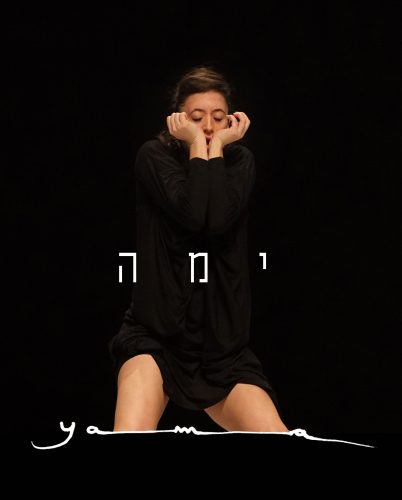
Ihr „Yama“, Ihre tänzerische See- und Tiefsee-Erkundungen haben in Geste und Bewegung mehr als
nur tief berührt. Für mich haben sie in Form und Ausdruck Spurenelemente einer „optimistischen
Tragödie“. So gesehen empfinde ich Ihre Choreografie wie eine bestechende Brechung und
Spiegelung, eines „Zwischenreiches“ von Menschen, die kaum noch freies Subjekt der Moderne und
ihrer Welt sind, sondern eher zu „Objekten“ der Macht der Verhältnisse geworden sind. Bedrängt,
belastet durch die Dinge, die Lasten, die Kuben, die über ihnen hängen und denen wir die Namen
Sachzwang, System, Struktur und Alternativlosigkeit geben, vom Terror und seinen grausamen
Feldzügen ganz abgesehen.
Als ich im Schlussbild die entblößte Frau, barfuß in freiester Bestimmtheit, entpanzert mit erhobenem
Arm ins „off“ abgehen sah, da empfand ich Sie und mich selbst wie Menschen, die nach all den
Lasten, nach all dem Unheil nur verschwinden wollen, sich vorher an der Tür noch einmal umdrehen,
weil Sie noch etwas sagen möchten, aber nichts mehr zu sagen haben, derweil der Rest der
Bekanntschaft sich weiter im rastlosen Kreise dreht. Alles auf Anfang.
Ich danke Ihnen für Ihre so bedrängende, aber ebenso befreiende Spiegelung unserer Befindlichkeit,
unseres Glücks und unserer freudlosen Verlorenheit, die uns nur zuflüstert nie nur uns selbst genug
zu sein, sondern sich in Gemeinschaft und Gemeinsamkeit jenseits von Ohnmacht und
Selbstbezogenheit der inneren Souveränität und Menschen-Zärtlichkeit zu versichern, ohne die eine
wirkliche Freiheit nie zu haben und zu leben ist.
Danke für diesen hinreißenden Abend voller Zorn, Zugeneigtheit und Melancholie, der uns im Inneren
Seekrank hinterlässt aber noch auf festem Boden
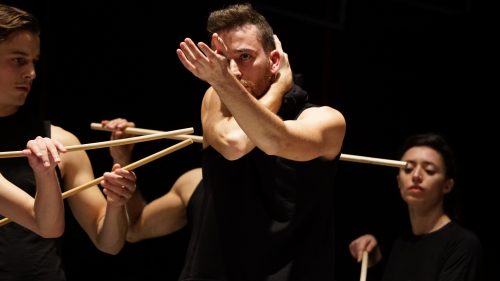
Noa wertheim talks a lot about the elements. “You are very air here and I need you to be more earth” is correction she has been known to giveto her dancers. When she speaks about fire,she isn’t only recognizing the positive elements but the potential dangerit possesses. “The same material can be soft and smooth and also strong and destructive,”says Wertheim over the phone.It is Sunday morning, and Wertheim ‘s dancers are just finish their warm-up, preparing for another intense day.The past few months have been busy for the members of Vertigo Dance Company. With new creation on the presses and multiple existing works being performed in Israel and abroad, they haven’t had much time to catch their breath. The new work, which will premiere next week, is study of the many faces of water. “I started research on Yama long time ago. started to look at movements that are at the extremes of the water spectrum.If water has no boundary, it will flow and flow. It keeps moving.On the other hand, if water is closed in on, it will explode in such powerful way that it can create tsunami,” she explain”s A.t the end of the day, there are very few things in the world that we don’t have any control over, and water isone of them.” The process, which beganlast year, saw significat unrtnover in the Vertigo cast. Where as Wertheim had grown accustomed to creat in aglongsid deancers who had been with her for several years, predominant new artists will perform Yama. “There was very challenging phase when tried to explore the movement material on group of my veteran dancers. Then, in September,had bigturn over of dancers. We had big tour. And then had to pass the material on to these new dancers. I’m used to working with dancers for five to eight years, Suddenly had change,and the oldest company member had been here for three years,s”he says In Yama, feel that was attracted to very deep cast. My new dancers are very deep, creative and ripe.The cast isvery strong,and enjoyit.It’s very special group,”she remarks. Wertheim explaints that the discovery of the material at hand occurred together with the discoveroy her cast. “Duringthe research, lot of things are revealed. It’s very interestingam. meeting the material and also the people at the same time. Like water, when you put person in corner, they can become monster,” she says. Another revelation that awaited Wertheim in the Yama journey came from her team of collaborators. Ran Bagno,who has worked with the company for more than 20 years, returned to write an original score for Yama. “It’s amazing to work with someone for so long and see that they can stil slurprise you,”she marvels. For costumes, Wertheim turned to fashion designer Sasson Kedem, whose black garbadds drama and volume to the movement. The set designer Swiss visual artist Nathalie Rodach, was the only new comer to the team. “Nathalie is doing the ater for the first time in her life.Several months ago she came to do residency at our ecologic vailllagien Kibbutz Netiv Halamed Hay. We got very close and had such great chemistry that we decided to work together on Yama. She went to the theater and measured, studied, learned the field. She did something very interestitng that really love,” she says. All the visual elements in Yama are black, fact that creates “local, Arabic, Middle Eastern” look to the work. “There is sense that something is being restrained on stage,that it is about to explode,”she says.
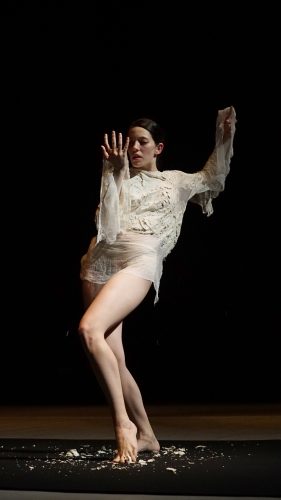
Noa Wertheimws new choreographique venture, Yama, is a amalgam of poetic mysticism, new-age spirituality and acute perceptiv enesofs space, allof which create pleasing beauty. This is true ot only for Yama but probably for most of Wertheim’s pieces. These elements have always been there, but as the years pass her craft gets more polished the seams tighter and the other stage components, particularly music (arranged for Yama by Ran Begano),lighting (design by Dani Fishof Magenta) and costumes (by designer Sasson Kedem) so cohesive it seems the entire team is geared toward preconceived aesthetic goal. Yet the work, as with any art form, would have been enriched by some subversive undercurrents. Yama opens with ceremonial entrance of dancers through line of black screens on both wings of the stage. Dressed in flowing black fabric,their exposed faces, arms and legg slow with warm light, and the movement is silky smooth, suggest in gritual. The mood is pensiveand rather somber. Later, itturns oppressivaes oversize geometric boxes hovering above descend slowly and stop four feet above the stage, meaning that each movement needs readjustment for the constrained space. The second appearance of the descending objects toward the end their presence ominous and dark actuall myoved the dramatic flow and allowed the dance to peak. One could see the constant effort to leave no loose ends and iron all the creases, yet one scene remained strange appendix, depicting six dancers holding long wooden sticks, poking victim in the center to death. lineof dances with sticks flooded my mind;from many ethnic dances to semi-theatrical ones by Sara Levi Tanai made for the old Inbal era, decades ago. Except that Yama didn’t build thematic or stylist conctext to justify this choice. In short, Yama is as beautiful as it comes from Vertigo productionsI. It didn’t rattleits safe zone much, but kepthigha esthetics, with one foot in spiritual spheres and the other planted strongly on earth. It enjoyed group of good dancers, particularthley new favorite:Ty Alexander Cheng, strongdancer of Afro-Chinese-Irish-Philippine descent
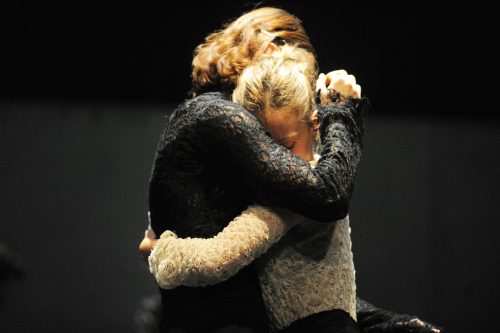
Even after the performance ended and the music and the lights went out, it seemed it was difficult to break away from thoughts of Yama, the dance performance produced by choreographer Noa Wertheim, artistic director of the Vertigo Dance Company. Charged with high level of emotional intelligence and a tendency towards aesthetic somberness, Wertheim sewed together a lyrical dance format capable of moving you to tears, an emotional experience etched deep in the mind. With every expression or movement; note in the composition; stitch and fold of the clothing; lighting, dimming or darkening; as well as each phase of movement and sound; and the whirl and flutter of costumes, all revealing an exciting and passionate artistic experience, bringing forward a performance and especially the content of a courageous work of art. Each aspect of this production is an art in itself, while the fabric of it all incorporating Wertheim’s dance language, the uplifting and virtuoso music of Ran Bagno, sculpture of the beautiful whirling costumes designed by Sasson Kedem, the striking lighting designed by Danny Fishof, and the dark stage paneled in black designed by Nathalie Rodach, creating a wonderful aesthetic harmony and adding to the intensive experience of this dance performance. However the content was left to be deciphered or imagined. “Description of content was left out of the printed program to allow individual interpretation and imagination,” said Adi Sha’al, Wertheim’s life partner, a dancer, CEO, cofounder, and co- artistic director of the Vertigo Dance Company. And all for the better for imagination with no barriers. Vertigo is more than a motion sensation, Vertigo dance company and performance reflect the vision of two young dancers whose paths have crossed on the dance stage. A meeting between Noa Wertheim and Adi Sha’al that weaved a love story, a creative duet, both personal and artistic. About 24 years have passed since they created their first duet naming it Vertigo, and since they founded a dance company under the same title based to this date at the Gerard Bechar Center in Jerusalem. Their life during those years have become an ongoing motion of activity, imagination and artistic creation while the Vertigo Dance Company performs in near and far destinations across the country and abroad becoming a leading modern dance troupe. Vertigo’s impressive repertoire depicts a dance style and language formulated by Wertheim, the artistic director, a collection of original works whose titles correspond with their complex journey through realms of dance and ideology. Each performance representing a chapter in the ideational life path of Noa and Adi and in the existence of the Vertigo Dance Company, incorporating artistic collaborations with dancers, choreographers and troupes from abroad. At one point, Wertheim and Sha’al began to look for a place, close to nature, where they can raise and educate their children in the spirit of a lifestyle they both aspired for. The ideal location was found in Kibbutz Netiv HaLamed Heh that welcomed them and their notion of establishing an integrated Arts center. Their Jerusalem base was never abandoned as they continue their work from both locations, however they chose to build their own home in the green landscape of the Ella valley. Nevertheless they did not move there alone, joined by Noa’s three sisters together with their spouses and children to create a family community lifestyle in this cultural and ecological oasis. Indeed, a unique residential village established to offer workshops and training to promote artistic dance in the light of community and spiritual awareness, and the ecological way of life. Rina, the youngest of Noa’s three sisters, a versatile and experienced dancer, is a principal dancer in the company and right hand to Wertheim in teaching the Vertigo distinct dance language. The other two sisters lead workshops at the center as well: Tally instructs the Power of Balance workshop supporting and guiding disabled participants through dance techniques based on contact improvisation, movement and listening; Merav, the eldest sister, leads a workshop that teaches the art of spiritual healing. Eventually, and for various accumulated reasons and factors, the Vertigo Eco-Art Village has become an established center attracting art and culture fans as well as local and international dancers and choreographers who come to explore the unique and educational experience, to collaborate with the company and participate in performances, workshops and artistic activities. I recently watched two dance pieces of choreographer Noa Wertheim performed by the Vertigo Dance Company, Vertigo 20 and Yama. An exciting experience and a challenging sheer pleasure that I cherish, inspiring though posing more questions than suggesting answers to highlight the dialogue between dance and perspective or movement and the visual and emotional expression. Vertigo20 is an artistic experience that evokes thoughts and reflections on the origin and nature of narratives and all that is told through the language of movement and choreography. I attempted to decipher the contents and although I was perhaps wrong, I enjoyed the freedom given to me to spread the wings of my imagination even if risking an error of interpretation due to my own impression. Indeed, I took the liberty to uninhibitedly imagine things to exist in places that are not necessarily obvious or even present. I imagined the weaving of relationships of love and hate, sensuality and rejection, reconciliation and violence, joy and sadness. Contrasts that I believe to be exposed through Wertheim’s solid dance pieces as she is engaged in surgery choreography, analyzing essences, the veins and arteries of movements and rhythms while sawing together notes and beats into a memorable experiential dance. Realizing that perhaps Wertheim can offer a more accurate insight of her intentions and creative vision I appreciated the opportunity given to me in between rehearsals to talk with her about dance, ecology, earth and nature, spirituality and roots, her life guidelines, arts and conventions. I met a special woman who leads a unique life in an extraordinary place. Our conversation, though offering some answers, has opened a great depth for questions and assumptions regarding her philosophy and the nature of the link between the art of dance and the ecological and spiritual experience characterizing Wertheim’s creative and communal conduct. Theatrical conventions usually imply content and text, a story or plot related to a certain time, period and place. Wertheim’s dance works are silent tales beginning with a single movement. Each movement representing a syllable, a sequence of movements forming silent motion words, phrases and contents. “I start with the material which I regard as the center of the body, bones and joints”, says Wertheim. “A dance begins with a single movement that is joined by another, structuring visual phrases and contents that make up the piece. After preliminary impressions are being formulated”, Wertheim says, “a creative discussion with costume designers, musicians and lighting designers begins”. In Vertigo 20, as well as previous works, Wertheim collaborated with costume and stage designer, Rakefet Levy. “Only after the syllables, words and phrases are selected, costumes are designed and the music is composed”, Wertheim notes. Levy succeeded, in a wonderful way, to weave a perfect fabric of contents, costumes and stage setting, while accentuating specific features such as the elegant appearance of the modern clothes and hints of humor and jest as appeared through costumes and sets to become integral artistic components of the show. “Vertigo 20 is a celebration of themes and principles accompanying us for over 20 years of creative work, a kind of retrospective of views and an observation of the essence of relations as a conscious choice or an act of coming into being”, emphasizes Wertheim. “Yama is a different show, burdensome and dark”, adds Wertheim that selected Sasson Kedem as the artistic costume designer. In fact Wertheim and Kedem are moving along the same line sharing the same spirit of creativity, Wertheim through her avant-garde movement language, and Kedem, one of the most original and revolutionary figure in local fashion scene, through his unique and innovative design language. These two artists cross-reference foreign artistic languages in this refined and precise creative merging and exquisite work of art, featuring a perfect correlation between the yet to be deciphered contents of Yama and the dramatic color of stage and clothes which are all painted black. Kedem links opposite extremes, avant-garde and the restrained, surreal and the practical, square sheets of fabric and rectangular, and triangles and circles, creating a quite incomprehensible artistically engineered tapestry. Generating motion in themselves, most striking garments correspond with body movements amplifying volumes and momentum of both costumes and dance. Can you mention someone from the dance scene that you are influenced by? “I appreciate the Modern Dance revolution led by Pina Bausch however I do not feel that I should aim to be like or identify with any character, artist, or creation. At different periods of time there may be some infiltrations echoing the subconscious imprints of previous experiences”. Wertheim does not apologize rather clarifying how through her creative work she relates to experiences and scenarios in her vicinity, things that happen in nature, in spirituality, ecology and our common responsibility to maintain world peace. How would you distinguish Yama? Yama is quite different in comparison with previous performances and choreographies, there is a different substance which is implied even through the music, costumes and stage setting, more significant and in control”, Wertheim concludes. And again for the better, especially in this case, allowing for individual interpretation of everything that happens and is shown in a courageous and forceful performance such as Yama. Indeed, it is quite understood that each of the artistic forces that make up the show have the right to exist independently while in the act , each complements and even enhances the presence of the other while joining together to form a strong creative non-competitive unit. “Noa is not a political choreographer but rather an experiential choreographer”, adds Eyal Vizner, former dancer of the Vertigo Dance Company and now the company’s director, following my meeting with Wertheim. “Every artist creates a world of its own. Our lives are like a closet with drawers, storing many things, and it does not matter which drawer was opened or what was our thought or intention while creating the dance, but what it stimulates in others”. Vizner is right, indeed Vertigo Dance Company’s performances stimulate and challenge you to dig deeper. After my experiential visit at the Vertigo Eco-Art Village in Kibbutz Netiv HaLamed Heh I also attended the premiere of Yama. I sat spellbind by all that was happening on the stage of the Vertigo dance theater that began with the thunderous opening sounds of war, the march of the drums and shooting that filled the space paneled in black sheets. A powerful opening that heralded, at least in my case and only in a nutshell, the impending excitement and drama, and a conclusion that is doubtfully optimistic. Perhaps in essence Wertheim is not a political choreographer, but the end result shows her being drawn into a reality restored through these dance fantasies. Therefore her tendency to depict the wind, nature and the earth, society and humanity as paving her conduct, requires her to carry the banner of protest to ensure their sustainability. In fact, implementing her total inner discipline and inherent poetic splendor, Wertheim has applied to the Vertigo contents and movement language some truths and beyond, what is visible and what may very well be discovered. Nowadays, when one cannot break away from the wave of political confrontation, what meaning other than political can be attributed to a performance like Yama? In Yama, Wertheim incorporates creative motifs that are intertwined throughout her rich repertoire, a journey that began with the duet performance of Vertigo marking the inauguration of her personal and creative life path with her partner, Adi Sha’al, and as expressed in other exciting duets. Stories that are told through spectacular gestures expressing encounters, conflicts and separations, longing and rejection, and even life and death, as can be implied by the duet depicting a male dancer carrying a helpless female dancer on his shoulders or by the weighty final scene. Another recurring theme in Wertheim’s dance is expressed through the circles – opening and closing life cycles flowing throughout their creative path and as a couple, as well as the traditional Israeli folk dance circles which seem to have a significant role in the blend. The selection of oriental music, the sound of drums echoing war, and the affinity to symbols borrowed from the local existence, sheds light on Wertheim’s sources of inspiration which apparently indicate that rather than confining herself to the artistic bubble she is indeed guided by everything that is going on around her. Another scene which to me seemed as pointing to an existing reality was the “dance of knives” in which dancers are carrying wooden poles as a symbol of the threat of terror (self-interpretation. NA). And alternatively throwing these wooden poles at what seemed like a prison wall or security fence. Other symbols of political confrontation were reflected through dancers raising their hands up and fingers marking the victory sign. The setting of black boxes as well, in my imagination resembles coffins, slowly descending from the ceiling as if threatening the space and therefore the existence of the dancers. To expand and deepen the conveyed message, Wertheim opts for a highly sensitive and painful finale, a Requiem played on the accordion by a dancer sitting on a “wave” of dancers, streaming, washing away and disappearing into the abyss. A pinch of optimism is detected in the “final dance” as the “professional weeper” on the accordion remove her black mourning dress and wears a white gown attached to her body with clay. Does Wertheim really try to conclude with a declaration of peace? Perhaps hope? Or maybe surrender? But that clay crumbles, the dress loosens and slides to the ground, leaving the naked dancer as she is walking into an unknown horizon. Have we really lost all hope? Wertheim leaves this question yet unanswered. The answer, as appeared in light of such an exquisite and pessimistic production, shall probably remain within the private reservoirs of hope.
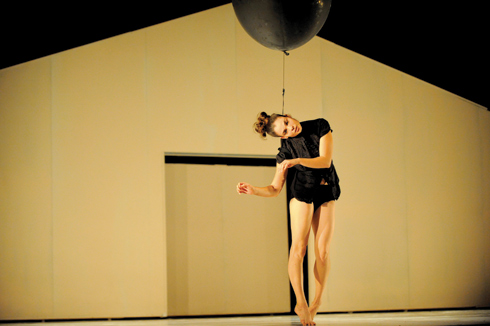
White Bird’s growing roster of exceptional Israeli modern dance companies has a new heavy hitter. The North American premiere of Vertigo Dance Company’s “Mana, Vessel of Light” is an hour-long study in duality – masculine and feminine, interior and exterior, forceful angularity against spiraling ritualism – choreographed by artistic director Noa Wertheim and arrestingly danced by her eight-member ensemble.
Wertheim’s title draws from the shattering of the primordial light depicted in the Zohar, the ancient text of Jewish mysticism, and early on, the earthy tribalism of the ensemble in unison suggests ceremonial surrender and physical transcendence. That religious subtext quickly fades. Wertheim is very much of the modern Israeli dance aesthetic; there’s a shared sensibility with the rich theatricality of Barak Marshall, the ecstatic ritualism of Ohad Naharin, the florid surrealism of Inbal Pinto. Like those powerhouses, Vertigo marries sharp abstraction to mind-teasing, sophisticated stage design.
The barest sketch of a house, like a child’s simplistic drawing, looms at the back of the stage. Over the course of the dance, it becomes animate, advancing and turning and receding, a mute and imposing framework into which dancers dissolve and then reappear. But it’s the dance, not the set, that holds the eye, at least until its jarring finale.
“Mana” begins with a single male dancer in layers of monk-like robes, feet firmly planted on the darkened stage, folding and slashing his arms in frantic cycles, fists to the sky. A kneeling onlooker, also robed, rises to join him, building an ecstatic rhythm in rocking sideways steps. Ran Bagno’s hypnotic score seems to float in the distance. The pair are a flurry of motion and stillness, extreme leans and backbends on the floor, so riveting that it’s startling to notice the door of the house has opened to reveal dancers meditatively walking interior passageways.
There’s an ecclesiastical solemnity to the growing cluster of dancers, clad in the long dark folds of Rakefet Levy’s exquisite costumes, circling, bending and stretching in silent unison. Palms out, snaking their bodies into curving crouches, the dancers’ movements seem to pulse as one collective organism. Unison is rarely this compelling on the modern dance stage, and Wertheim punctuates it with splinters of opposition flicking out in small gestures, gradually building to fervent spirals, barreling leaps and partners flipping over shoulders, adrenaline-fueled pure form circling back into an earthy vernacular.
“Mana” takes a turn to the surreal with the appearance of Rina Wertheim-Koren (Noa Wertheim’s younger sister) as a mechanical doll on tiptoes, her shoulders tethered to a black helium balloon. Against the shrouded ensemble, she’s all skin, long legs prancing and scissoring out, barely appearing to touch the stage.
From there, “Mana” evolves into an uneven juxtaposition of sacrament and martial arts, stylized sparring and sharp thrust and recoil against social dance and contact-improv manipulations. At its worst, it becomes an exaggerated, unoriginal take on gender wars, relegating the women to defiant or clinging foils against the militaristic kicking and stepping of the men.
By the end of the dance, the score has gone from meditative lullaby to hallucinatory carnival to rave-like electronica, and the choreography from abstract ritual to vamping dance club attitude. There’s not a weak link among the dancers in terms of technique, but as a culmination of intriguing ideas, it’s woefully anticlimactic. Just a hint of the old-time score trickles in to the clubhouse atmosphere, a time warp to when the unison of the dance seemed to be saying something more universal, more powerful than movement for movement’s sake.
The dancers are the real gems in Vertigo’snew work, ‘Reshimo,’ an aesthetic experiencethat projectsan energeticsense of continuity
Rachimo by Israel’s Vertigo Dance Company, refers, according to the company’s English-language website, to “the imprintof past impressionleftwithin. kabbalisticidea pertainingto the impressionof light the fine outline which remains when the lightsare gone and are no longer there.” ChoreographerNoa Wertheim sets out to giveform to the ineffable. “Reshimo” flows by like water, like lightwaves, which leave no trace and tellno story.Their presence is fleetinglyevanescent, inhabitingthe fine linebetween material and spiritual. Low, rectangularwhite lamp shades, evoking Japanese gardenor shrine, mark the boundaries of the stage,creatingan atmospherethat isclean,aesthetic,not to say ascetic.All eightdancers are on stageforthe entireperformance, sometimes sittingon the stoolsof light. There is quieton the stage duringthe dance, with flowingmotion of weight shifted from side to side.Graduallyall the dancers come togetherto forge connection ofwholeness, holdinghands in moving chain held togetherby energy. One of them utters syllable, which she repeats over and over as though wanting the sound to awaken the source of energy in the body,not relentinguntilthe palms of her hands are suffused with vibrationsand begin to shake Photos byMaayan Holam The dancers’ motions consist of small body-touchingmovements, which have characterized Wertheim’s work since her firstduet for Vertigoin .2991 These are accompaniedby virtuoso,but nevertheless soft,movements. The extremities of the body the palms of the hands and the feet are limp,as though to refrain from blockingthe inner tunnels of motion. The dancers are excellent, moving throughthe space with lightjumps as though trampoline-propelled,every motion honed and shining.Toward the end, autumn leaves cascade onto the stage,leaves that have ended theirlife and withered, dyingamid beauty,and the dancers of “Reshimo” commune with them, leapingupward intolifeand falling-rolling intothe leaves,as though desperateto disappearinto them and become one with nature. “Reshimo” is an aesthetic experience, projectinggratifyingcontinuity, without dramatic peaks.The real gems are the dancers.
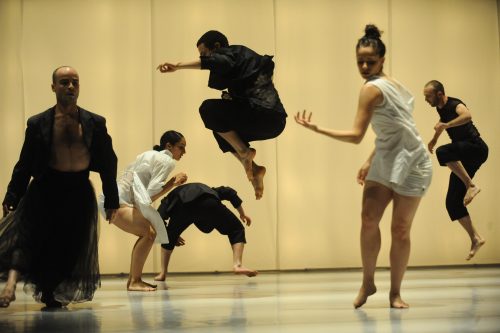
Dance is an art form created between people. With the exception of a solo performed by a choreographer, the process of creating a dance almost always involves several people: choreographer, dancers, rehearsal director, costume set and lighting designers, and musicians. Over time, a dance company becomes a community, for the Vertigo Dance Company this sense of community is an integral part of their vision.
Founded in 1992 by Noa Wertheim and Adi Sha’al, the Vertigo Dance Company has found long term artistic partners in composer Ran Bagno, artistic assistant Rina Wertheim Koren, rehearsal director Sandra Baron, costume and set designer Rakefet Levy and lighting designer Dani Fishof. Their dialogue is characterized by close relationships; while always open to experience and change, welcoming new ideas, collaborators and visitors to the creative community.
In this spirit, the company invited visitors to the studio in late April to watch rehearsals in progress for Noa Wertheim’s new work: NULL. The dance will premiere on June 12, 2011, opening the Karmiel Dance Festival 2011. In anticipation of the premiere, there will be a performance in Jerusalem on June 6, 2011 at the Gerard Bachar Centre, where the company has made its home for many years.
On entering the room, one change was immediately apparent: in this work Rina Wertheim Koren had moved from the dance floor to join Noa, the two sisters and Sandra observing the dancers intently. Taking a seat alongside them, some of the dancers were familiar to me, others, who have recently joined the company, I encountered for the first time.
As the dancers moved, I recognized the impulses I have come to identify with Noa’s work: a strong connection to the ground that pushes up to leap into the air, the ever-shifting balance of power and movement between the individual and the group, a presence at once symbolic and exuberantly physical. Large movements demanding strength, speed and agility are interwoven with moments of delicate nuance: a hand spirals down the length of the torso like a feather in the wind, three hand gestures in different relationship to the body repeat like words in sign or code at different intervals in the dance, acquiring a symbolic significance.
Noa briefly commented to me that as she was in the process of editing the work, the dancers were not dancing full out, but only marking. The three women observed, reflected and commented on the dance as it took form on the studio floor, and the dancers commented freely as well. Trying out different sequences, experimenting, repeating the same section over and over again, yet each time with a subtle difference that alters the feel of the movement. The intensity of the work is difficult to imagine, commanding complete dedication of the body and mind, it is mesmerizing to observe.
When the dancers took a break, Noa took time out from NULL to tell me about the work in progress. “The music is growing with the work,” she said, “What I am seeing now is in different sequence. Two weeks ago I had 50 minutes on silence; the costumes were set up, half the info was there.”
Noa explained that in embarking on NULL, Ran Bagno, who has composed original music for most of Noa Wertheim’s choreography, “felt that the dialogue we were accustomed to in the past wouldn’t bring out this work to its fullest. I love to work with him, we’ve been working together for 15 years and I wanted him to stay with me.” The solution they found was to add a musical partner, Stefan Ferry, a former dancer with the Batsheva Dance Company who had worked with the Vertigo Dance Workshop, to “bring something new into the mix.”
The process was not always easy, recalled Noa, “We each have different languages, different perspectives. We had some difficult moments, but suddenly this week something started happening. Stefan brought another dimension into the soundtrack, layering the sound. Ran and I never worked like this before. I still don’t understand what is happening…”
In the empty space of the studio, Noa gestured to indicate the visual aspects of NULL, saying, “On the right there will be a white fabric lit from behind and also on the back two flat strips will create large walls of light, and the audience will be somewhat lit. I never saw it; I just have it in my mind. We saw a model. Rakefet Levi and Dani Fishof are working together. There will be white bathroom tiles on the fourth wall; it somehow reminds me of teeth…and some source of water like a sink that reminds me of a public bath.”
The flow of her words, images, ideas and associations is as free, fast and full of same explosive energy she brings to her work on the stage. Noa explained that in this work she began by researching the movement on silence, the advantage being that “without sound I can always play with the editing.” This process of editing, is what I had the opportunity to experience in the studio, to see the work in the eyes of the choreographer as she saw it in that moment. “Everything is open,” she said, “like Lego.”
“I always have two motives that are opposite,” said Noa reflecting on her work, “The world is always structured that way – good and bad. Mana related to the space and the new work, NULL relates to time.” She explained the kind of exploration undertaken in the work, demonstrating that “different movements contain the same energy, released in different time segments for a very different feel and impact.” She said that this work also originates in the experience of her relationship to time as a woman reflecting on her life, “All I do is listen to something deep that exists in the universe, give myself up to it, and begin to create a world, in layer upon layer, connected to time.”

Those new people in that big white house, the ones who keep coming and going and gathering out front—what are they doing, exactly?
As it turns out, they are Vertigo Dance Company and they’re just visiting for the weekend. They’ve come all the way from Jerusalem to share a contemporary dance piece called Mana, Vessel of Light with us, and this is their first time on the West Coast, so we should be hospitable—maybe bring them a fruit basket.
But first, let’s talk about Mana, a remarkable work that choreographer Noa Wertheim has made, according to program notes, from “unique movement composed of a spiral structure that gathers energetic momentum …” There’s more, but that’s a good starting place. Mana—which takes place in and around a set designed to look like a large white house—does indeed have a spiraling motif. Some of that comes from the individual movement of these well-trained dancers, including wonderfully fluid recurring torso rolls that initiate at the waist and undulate up through the top of the head. There are also sweeping flexed-foot barrel turns, beautifully executed by men in long tunics, skirts and wide-legged trousers that wing out to the sides, expanding the movement’s radius. These, in turn, are done in larger group circles, as are big waltzy duets between the company’s four men and its four skirt-and-headscarf-wearing women.
The circular motif is punctuated by ritualistic and gestural movement, duets in which the dancers roughly manipulate their partners’ limbs and features, and a section in which the performers, performing in bright spotlight, cast long dancing shadows of themselves across the house’s front. Occasionally, a girl in short shorts slinks along the back of the stage carrying a large silvery balloon.
Who these people are, and what their relationships are to one another, is subject to debate. The plain costumes and intensely focused movement bring various international personages to mind, from whirling dervishes to Buddhist monks. The no-frills set and the music, which incorporates march and waltz rhythms into an echo-y klezmerish score, suggests something more like kibbutz dwellers. Taken as a whole, this place and its inhabitants could reflect the multicultural crossroads that is Israel. Whatever you may take away from it when you leave, Mana, Vessel of Light is a mesmerizing hour of dance—and a visit worth paying.
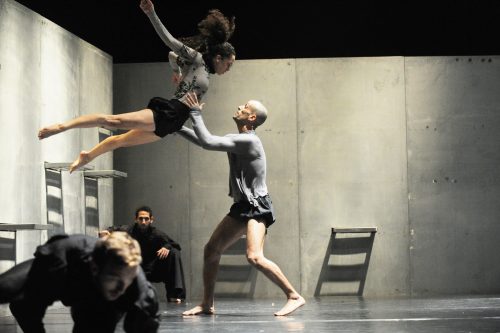
“I never had this plan in my mind,” said choreographer Noa Wertheim, reflecting on her dreams as a young dancer at the start of her career. Yet a friendship with a fellow member of the Jerusalem Tamar Dance Company quickly developed into both an artistic and romantic collaboration, she explained in a Skype interview alongside her now-husband Adi Sha’al.
“We just wanted an excuse to meet in the studio. That’s the real story,” she said, both of them laughing. What began as a duet between her and Sha’al in 1992 has not only developed into one of Israel’s leading contemporary dance troupes, but a new way of life, a community of environmentally conscious artists.
This weekend (Oct. 29-30), 12 dancers in the Jerusalem-based Vertigo Dance Company will make their Boston debut, performing “Vertigo 20” at the Shubert Theatre as part of the Celebrity Series of Boston.
Created in 2012 in honor of the company’s 20th anniversary, “Vertigo 20” is a compilation of past works, a walk through history with pieces of choreography from the original duet to present repertoire. Through the creation process, however, “Vertigo 20” took a shape of its own. “Just the people who know the company very deep can recognize which [choreography] belongs to what,” said Sha’al, general manager and co-artistic director.
The piece is a celebration, Wertheim explained, but an element of contradiction adds an emotional depth to the theatricality of the work. The dancers are dressed as clowns, but the atmosphere remains sophisticated and heavy, she said, describing a poetic moment of 20 white balloons filling the stage.
“The question of choice, the game between heaven and earth bothers me a lot,” Wertheim said. “When you dig and find the nice place of the unknown, and you try to put it in a visual, physical way, it is art for me.” A philosophical uncertainty is apparent throughout her work, perhaps inspired by her strong connection to Kabbalah, a mystical Jewish philosophy. At one point, the dancers sit on shelves of metal. Their feet dangle over the edge, she explained, the space between them and the floor symbolizing that between our world and the world to come.
The music by Israeli composer Ran Bagno, the company’s musical director, only emphasizes the profoundness of the piece. “We see the flavor, the atmosphere the piece needs,” Wertheim said, “and then he decides the instruments and starts writing.” Incorporating music after she begins the choreographic process might seem unconventional, but neither Wertheim nor Sha’al have followed a traditional path.
Both of their careers began late — around the age of 21. “Noa because she’s coming from a religious background, and it was not considered modest enough,” Sha’al said. “Me personally, dance was not for men in this country.”
However, after completing Israel’s mandatory military service (two years for women and three years for men) and volunteering an extra year, the artists found their way to dance. Their original duet, “Vertigo,” stems from Sha’al’s firsthand experience as a pilot in the air force. “We took this feeling of dizziness, or vertigo,” Sha’al said, “and we projected it from the world of flying into dance, into relationships.”
In a way, relationships lie at the root of the couple’s work. Nine years ago, Wertheim and her three sisters created Eco-Art Village, an eco-friendly, tribal community that unites individuals of diverse populations, those with different religions, cultures, abilities, and more. The sisters live together with their families (Wertheim and Sha’al have 3 boys) at the Village, which overlooks the Valley of Elah, where David once defeated Goliath.
“We are focusing quite a lot on three pillars, which is art, human, and nature,” Sha’al said. “I think what is unique about Vertigo is this holistic way of thinking.”
The Village is not the first time Vertigo Dance Company has explored social innovations. In 2001, the troupe performed “The Power of Balance” by choreographer Adam Benjamin, a work that unites company members and physically challenged individuals onstage. Due to the show’s success, the company developed an integrated dance program by the same name.
Another branch of Vertigo is its International Dance Program, where students from around the world, ages 18-25, study Wertheim’s style of contemporary movement called the “Language of Vertigo.” Offering more than dance training, the program also encompasses the ideology of the company, and the artists live where they work — at the Eco-Art Village.
This way of life, a life of artistry, collaboration, sustainability and community, is what the couple aspires to share with audiences around the world. “It’s very real for myself, this family oneness,” Wertheim said. “The life and the art is one. I don’t separate it. I go to the studio, and it’s part of my life, part of my family.”

When I called Adi Sha’al and Noa Wertheim, who direct the Vertigo Dance Company, they had just landed in Israel after an appearance at the General Assembly of The Jewish Federations of North America in Washington D.C. There they had presented an excerpt from Wertheim’s Mana, which will be officially premiered in Curtain 2 along with Elad Shechter’s Roni. I chatted with the couple about their U.S. trip and their experience with Curtain Up
Dance In Israel: How was your time at the General Assembly?
Adi Sha’al: People were very moved by Vertigo’s performance, and people came [up to us] afterwards, after they were clapping hands for a long time and standing up – some people even with tears. We also talked about our social vision of the company and the Eco-Art Village . . . And we also did workshops and created connections with dance companies in D.C.
DII: What is your relationship to Curtain Up?
AS: It’s been a good relationship. Vertigo [Dance Company] has been around for 17 years now, and all of our first shows were under this title, under Curtain Up. We owe a lot to this institute.
DII: What drew you and Noa to select Elad Shechter to be the choreographer for this program?
AS: Elad used to be a dancer in our company, so we’ve known him for several years now. Once Nilly Cohen [director of the dance department in the Culture and Arts Administration] and the people at Haramat Masach came with the idea of coaching, we said basically the only one that we can really coach and we can say that it will be real for us is somebody that we know, somebody that we have a dialogue with.
AS: In a way, we are marking here two companies. One is the main company which Noa is doing a piece for, and the other one is the young company, the Vertigo Ensemble, which Elad is doing a work for, and it’s [all] happening in Vertigo’s studios under the umbrella of Vertigo’s production. And we [work with] the same co-artists. Ran Bagno is making the music for both pieces; he’s a musician we’ve been working with together many years now. Danny Fishof, he’s our lighting designer; he is doing the lighting design for both pieces, Mana and Roni. And the costume designer is Rakefet Levy; she’s doing both pieces. So we feel like it’s a production house called Vertigo, and it’s very exciting for us to do these two things together side-by-side in the same evening.
DII: Noa, can you tell me a bit about where Mana came from?
Noa Wertheim: I like to work from the movement, and I never have a clear idea, but I do have a certain attraction to something. This time, the line and the circle came straight away. After I was dealing with Ra’ash Lavan [Noa’s previous work, White Noise], where gravity was so important, it was different to work with the shapes.